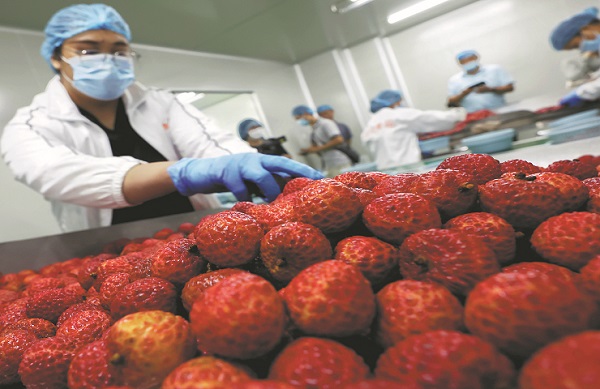Lychee freshness sees quantum leap

Workers select lychee in an ultralow temperature lychee preservation production line. ZHENG ERQI/FOR CHINA DAILY
Meanwhile, Wang Hongjun, a professor at South China Agricultural University, said a 5G-powered robotic picker that mimics the movements of human hands has been introduced to help pick the fruit.
The lychee-picking robots equipped with binocular cameras, combined with machine learning and bionic knowledge with the support of image processing algorithms, can autonomously recognize fruit clusters in complex outdoor environments and accurately locate the three-dimensional spatial position of fruit clusters to realize unmanned harvesting and transportation to improve overall efficiency, he said.
The new technologies will help reduce labor inputs, and promote industry scale, mechanization and intelligent management of the lychee industry in the months to come, added Wang.
The Guangzhou bureau of science and technology said the South China metropolis is one of the major production bases for lychee in the country in terms of research strength, investment input, promotion and application of lychee technology.
The bureau has given strong support to scientists tackling the problem of lychee freshness guarantees in the past year, the authority said.
Chen Houbin, another professor at South China Agricultural University, is the chief scientist with the National Litchi Longan Industrial Technology System.
Chen urged related departments to rely on technology to promote high-quality development of the lychee industry in the following months.
"More lychee varieties with better temperature requirements should be cultivated through seed selection, hybridization and biotechnology methods," he said.
Ouyang Jianzhong, director of the Conghua Lychee Industry Research Institute, said the new lychee freezing and dormant technologies — which extend shelf life to a year — have helped solve seasonal centralized marketing and sales problems, and expand sales scope and sales cycles, thus achieving year-round global sales, greatly improving the export scale of lychee and expanding export destination countries.
Ouyang said thanks to the new freshness preservation technology, his company has also sold the fruit to South America, Russia and the Middle East this year, based on the original 15 countries and regions in North America, Europe, Southeast Asia, and China's Hong Kong and Macao.
Ouyang, who is also chairman of Hualong Fruit and Vegetable Preservation Co Ltd, said his company — which has 6.67 million square meters of lychee orchards — has taken the lead in the country to build the country's first fruit and vegetable ultralow temperature immersion freezing and freshness locking production line in July of 2023 to help extend the shelf life fruits and vegetables.
Lin Changzhen, director of the Caixianyuan Fruit and Vegetable Cooperative in Gaozhou, Guangdong, said her cooperative has been using multiple methods, including expanding e-commerce platform channels, training professional talent and enhancing industrial technology to help expand lychee sales, stabilize the market and increase income this year when lychee output has witnessed a reduction.
But extending lychee shelf life is also important, as the fruit is highly seasonal, and its sales period usually starts from May and ends in July, she said.
As a brand agricultural product, lychee has enjoyed rapid development in recent years.
However, storage and transportation losses are significant due to the preservation bottlenecks.
According to official statistics, lychee growers and traders in China suffer losses of 18-30 percent in the circulation process after harvesting, with an annual loss of about 4 billion yuan ($555.56 million), compared with less than 5 percent recorded by developed countries and regions.
China's annual export volume of fresh lychee reaches less than 10,000 metric tons, accounting for about 0.3 percent of the country's total production of the fruit.
Subtropical Guangdong, with a lychee planting area of 2,633.27 square kilometers, usually produces 1.3 million tons of the fruit annually — more than 50 percent of the country's total output. Other production locations include the Guangxi Zhuang autonomous region, the provinces of Hainan and Sichuan, and Taiwan.
However, affected by warmer winters and the continuous extreme weather, including storms, hail and tornadoes, that hit the province this year, Guangdong's lychee harvest has witnessed a year-on-year reduction of more than 50 percent so far this year, authorities said.
According to official statistics, the output of lychee in Guangdong is expected to hit 876,400 tons this year, down 51 percent year-on-year, authorities said.
The predicted output of lychee across the country this year is estimated to be 1.78 million tons, down 42.5 percent from last year.
Copyright © Foreign Affairs Office of Guangzhou Municipal Government,
Hong Kong and Macao Affairs Office of Guangzhou Municipal Government All rights reserved.
Presented by China Daily.
京ICP备13028878号-28



